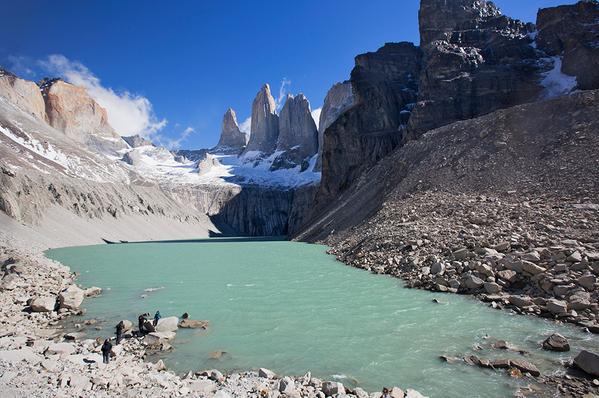With its aquamarine lakes, undulating tawny steppe, and granite teeth poking skyward, Patagonia’s scenery is second to none. Then there’s the wildlife — Andean condor, herds of guanaco (a South American camelid), and the elusive puma. This is the end of the world as you only imagined, so where does one start? These considerations can help you make the most of your trek.

The granite peaks of Torres del Paine reach as high as 2,500m or 8,200 ft.
1. Summer’s not always summery
Most visitors hit the park between December and February. Seduced by escaping winter in the northern climes, many will under-pack warm layers. Yet snowfall on Gardner Pass is always a possibility. Torres del Paine can experience four seasons in a day, so bring thermals, hats, and waterproofs. Forget the cotton anything. Shorts fanatics may insist on one pair, but be forewarned: thorny bushes might break your stride.

Dress in layers and be prepared for colder weather.
2. What’s the rush?
Summer days last long — the sun sets after 10 p.m. in December. With up to 17 hours of daylight, hiking is only half the story. So how to spend those hours?
Seek out wildlife. In the forest listen for Austral woodpeckers — the male’s crimson crest stands out and they’re not skittish. Keep an eye out for condors with their 3m (3.8 ft) wingspan soaring in the section between Glacier Grey and Mountain Lodge Paine Grande, or in the French Valley. Guanaco herds roam the steppe, usually spotted on the shuttle ride in. For red fox or puma keep an eye out at dawn or dusk.
Take in the views. One of the best is the massive Glacier Gray extending from the Southern Ice Field, the largest non-polar ice stretch in the world. Hiking down Gardner Pass, the view unfurls for hours. Stop and take it in, colours, crevices, and all. Or, take a cue from the gauchos and cat nap in the shade of a southern beech.

Keep your eyes peeled for herds of guanaco.
3. Go against the tide
As one of South America’s top attractions, Torres del Paine can be more popular than most visitors anticipate, particularly in January and February. That can mean a party atmosphere at the granite towers of the Torres lookout, or an overcrowded dinner table at the Refugio. For some reason, most hikers adopt the same schedule. Leave a little later in the morning, let big groups pass you by, and take off-hour breaks in less obvious spots and you can have much of the trail to yourself, especially in the long sunlight hours of summer.

Try and stagger your breaks away from other groups to maximize your time with the landscape.
4. Don’t get blown away
Stronger than a pro-wrestler (and just as surly), Patagonian wind can lift grown men with a full pack off the ground. Trekking poles can keep you connected to the ground — not to mention their utility for descents and stream crossings. Pack covers are also easily blown away. So instead, line your pack with a trash bag liner to keep it waterproof. And at camp, keep everything tucked in your tent.

Take steps to keep the inside of your tent dry.
5. Stay powered up
You might be surprised by how fast your phone and camera batteries drain. Ease the run on refugios, which run on limited generator power, by bringing your own small solar charger or power bank.

Pack your own batteries as refugios run on generators.
Getting There
G Adventures runs a number of departures in Patagonia encompassing a wide range of departure dates and activities to cater to different tastes. We’re thrilled at the prospect of showing you this big blue planet of ours — check out our small group trips here.























